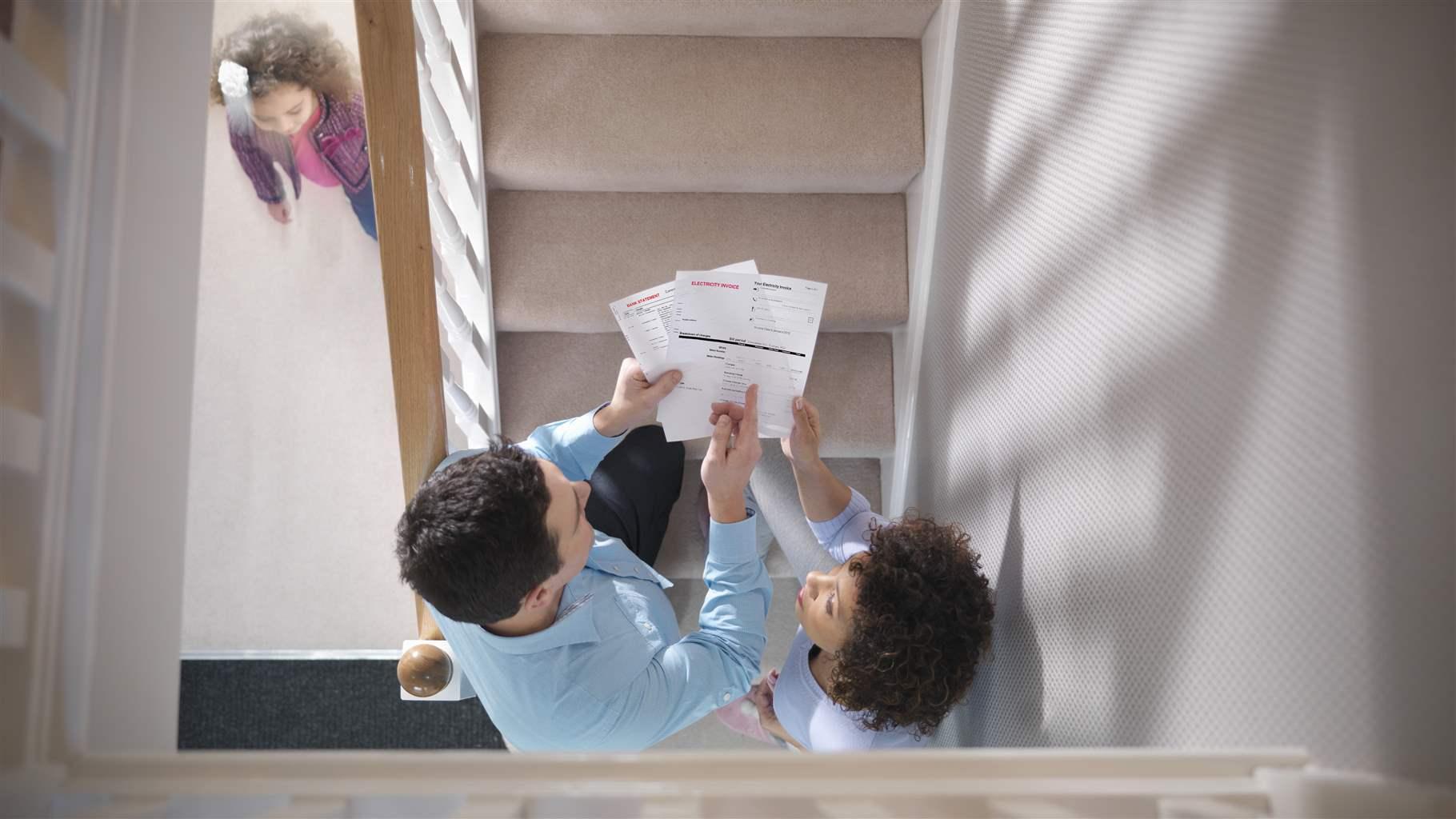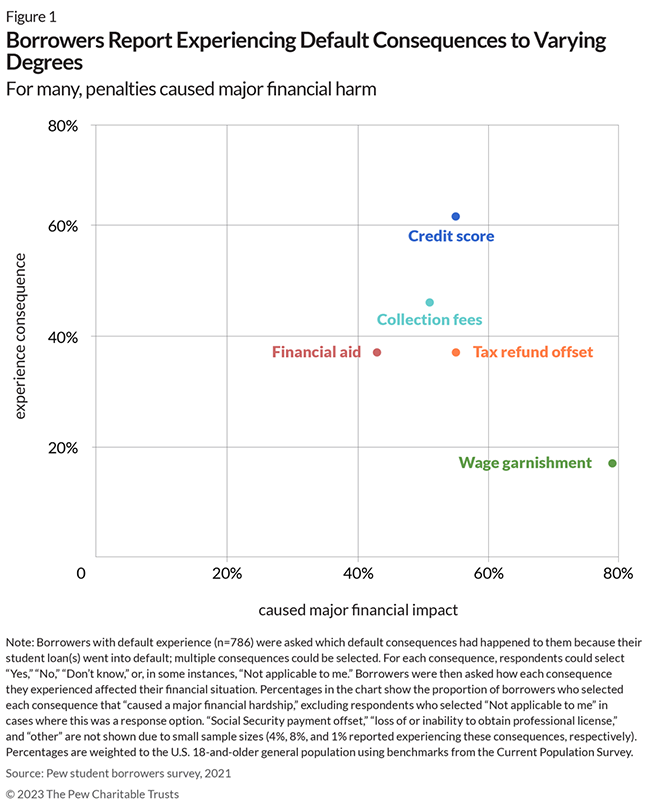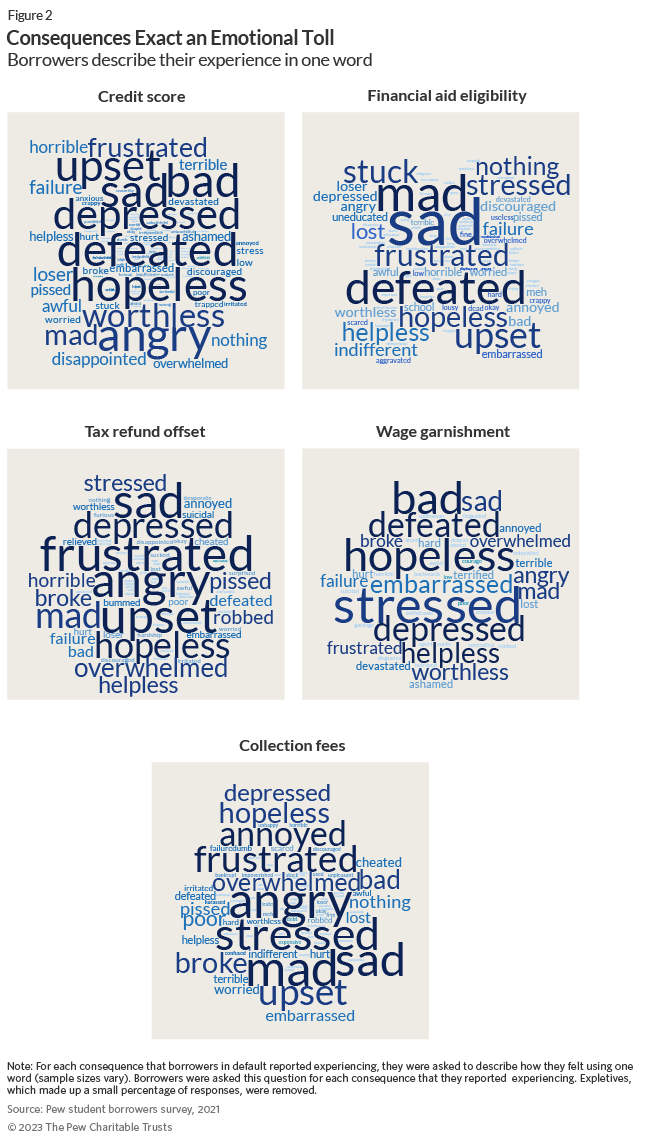At What Cost? The Impact of Student Loan Default on Borrowers
Pew survey highlights the need to re-examine current collection practices amid government reforms

Overview
Among borrowers who have faced student loan default over the past two decades, a majority have experienced multiple consequences—and for many, these penalties have had a major financial impact, according to a new survey from The Pew Charitable Trusts. Although borrowers are largely cognizant that default carries consequences, awareness of specific consequences varies widely, which can cause borrowers to experience penalties they didn’t anticipate.
Student loans generally fall into default after 270 days of missed payments, though penalties typically aren’t imposed until after 425 days.1 The consequences of default can range from ineligibility to receive more federal financial aid or having the default reported to credit bureaus, to forced collections practices like tax refund and Social Security benefit confiscation, and paycheck garnishment, as well as associated fees. (See box below for additional detail.)
Pew’s research highlights the critical importance of looking beyond how the penalties listed above influence borrower behavior to understand the financial impact such penalties have on borrowers. Although there is some evidence that the threat of such consequences may cause borrowers to take actions to repay their loans, Pew’s survey findings also imply consequences can impose considerable costs on what past research suggests is an often vulnerable group. For example, past studies have found that borrowers who had greater financial need while enrolled in school or lower incomes while in repayment were more likely to have experienced default.2
The findings in this brief have particular significance because past research has shown that Black and Hispanic borrowers disproportionately experience default, as do women.3 This is not to say that race, ethnicity, or gender inherently lead to poor repayment outcomes. Rather, factors that disproportionately affect these groups—historic and persisting income and wealth gaps, as well as labor and housing market discrimination—could be at play here.4
Despite the presence of penalties that many borrowers perceive as causing significant hardship, default and redefault are alarmingly common: According to the survey, 35% of undergraduate borrowers have experienced default over the past two decades and two-thirds of those borrowers have defaulted more than once.5 This raises questions about the extent to which the current collections system and the penalties it imposes are promoting successful repayment.
To help inform ongoing and future policy discussions about reforming the repayment system to set borrowers on a better path to success, this brief provides novel insights from Pew’s survey findings related to three aspects of borrowers’ experiences with default-related penalties:
- Nearly all borrowers who have had a loan default (84%) reported experiencing at least one consequence, with the majority experiencing two or more (59%).
- Many borrowers (varying from 43% to 79% depending on the penalty) who experienced consequences said the penalties had a major financial impact on them.
- Overall awareness of consequences is very high (82%), but awareness of specific consequences varies (from 30% to 50%), leading many to experience consequences they did not anticipate.

Several policies that affect student loan borrowers and default have been announced by the current administration
The Biden administration has announced a number of reforms and initiatives to the student loan repayment system. In August, President Joe Biden shared his long-anticipated decision to forgive up to $10,000 of federal student loans for borrowers whose annual income is less than $125,000. This forgiveness would increase to up to $20,000 for borrowers who ever received Pell grants.6 In conjunction with this decision, the ongoing student loan payment pause that went into effect in March 2020 in response to hardship brought on by the pandemic has continued to be extended for the foreseeable future.7 And the U.S. Department of Education has proposed revising income-driven repayment to generate lower payments for borrowers.8
Additionally, the Education Department announced this past summer that most borrowers who were in default prior to the pause will be able to enter repayment in good standing, provided they “opt in” by having their loans transferred to a “non-default servicer” or apply for additional federal financial aid within one year of the end of the payment pause.9 This means that collections on most defaulted loans will remain on hold for a year after repayment resumes. The department also ended the role of private collection agencies in the student loan repayment system and plans to transfer these accounts to business process operations vendors whose purpose is to support all borrowers through the entirety of the student loan life cycle, regardless of default status.10 Finally, the Education Department has announced rule-making specifically related to debt collection practices.11 All of these initiatives provide federal policymakers with a rare opportunity to re-evaluate and reform the student loan collections system and the penalties associated with default.
Consequences Associated With Federal Student Loan Default
Before the current payment pause on federal student loans, defaulted loans were transferred from their assigned servicer to a private collection agency (PCA) through the Department of Education’s Default Resolution Group. The Department of Education published a list of consequences that borrowers with a defaulted loan can experience.12 They include:
Acceleration. Upon entering default, the entire remaining amount of the loan, along with any accumulated interest, becomes due immediately. Interest also continues to accrue while a loan is in default, which is different from how private markets typically operate.
Collection fees. A percentage of each payment made or collected from a defaulted loan is typically set aside as a fee for collections, which does not count toward bringing down a borrower’s balance. These fees vary widely—from nonexistent to upwards of approximately 24% of principal and interest—depending on one’s default exit path.13 The Education Department sets these fee structures, which can be very opaque to borrowers as they are not widely communicated or published.
Ineligibility for financial aid. Borrowers with a defaulted loan are barred from accessing additional federal student aid, such as grants or loans.
Ineligibility for repayment plan enrollment. Once a loan is transferred to a PCA, borrowers are no longer able to enroll in or switch across different repayment plans.14 This includes income-driven repayment (IDR) plans, for which borrowers become ineligible to enroll after 360 days of missed payments.15
Loss of professional license. In some states, borrowers with defaulted loans can have their drivers’ or professional licenses suspended. A 2018 report found that 18 states had such laws in place, although enforcement varied widely.16
Notation on credit. Servicers are required to report loans to major credit bureaus once payments are 90 days late and after entering default. This results in borrowers experiencing a drop in their credit during the period leading up to default and a separate notation on their credit once the default occurs, which can make it more difficult for borrowers to access other forms of consumer credit, such as credit cards, auto loans, and mortgages.17 The default notation can remain on borrowers’ credit reports for seven years.18
Treasury offsets. The government has the ability to withhold borrowers’ tax refunds and Social Security checks to collect on a defaulted loan. There are no limits as to how long one’s tax refunds can be offset, or how much can be seized.19 Social Security offsets are set at the lesser of 15% of one’s monthly benefit payment or the amount by which the benefit surpasses $750 per month.20
Wage garnishment. The government can also require employers to withhold the lesser amount of either a) up to 15% of borrowers’ remaining income after mandatory deductions, such as taxes and health care premiums, or b) the amount of income after deductions exceeding 30 times the current minimum wage (which is about $218 per week).21 Once implemented, wage garnishment typically continues until either the defaulted loan is repaid or the loan exits default through other avenues.22 Wage garnishment can occur at the same time as Treasury offset and other consequences of default.23
Nearly all borrowers who have had their loans go into default reported experiencing at least one consequence, with the majority facing two or more
The vast majority (84%) of borrowers with default experience state that they faced at least one consequence of default.
Borrowers with default experience most often cited having a drop in their credit score (62%), followed by collection fees (47%), tax refund offsets and ineligibility for more federal financial aid (both 37%). (See Figure 1.) Wage garnishment had relatively lower reporting (17%), potentially due to the high logistical and administrative burden of implementation.24 Having a professional license suspended (8%) and Social Security offsets (4%) were more rarely reported.
Nearly 6 in 10 borrowers (59%) who have had a defaulted loan reported experiencing two or more consequences, meaning most borrowers need to navigate a series of penalties while figuring out how to bring their loans back into good standing. More than half of all borrowers who have had their wages garnished, for example, had their tax refunds confiscated.
Note that borrowers’ reports of experience with a consequence of default may reflect limited awareness of all of the relevant consequences. For example, borrowers might not know that they are ineligible for additional federal financial aid unless they try to go back to school. And since collection fees come out of borrowers’ payments while in default, many may not understand how much of their payments are actually going toward collection fees versus paying down their debt.
Many borrowers who experience consequences said that they had a major financial impact
A second key metric for understanding how borrowers experience default-related consequences is the extent to which those consequences have affected them financially.
When asked how much of a financial impact each consequence had on borrowers that experienced them, the proportion that reported a “major” financial impact varied from 43% (ineligibility for financial aid) to 79% (wage garnishment).
As mentioned earlier, a drop in credit score was the most widely experienced penalty, and 55% of those who reported experiencing it said that consequence had a “major” financial impact on them. (See Figure 1.) It is worth noting that the lowering of a credit score is an event that can result from factors independent from one’s student loans (e.g., bankruptcy, delinquency, or default on other debts).25 Prior research has shown that those who experience default are more likely to have lower-than-average credit scores even before repayment begins, signaling that successful student loan repayment alone won’t necessarily fix this challenge for many borrowers.26
Wage garnishment, on the other hand, was not experienced nearly as widely—but its financial impact was felt more adversely by a larger share of those who were subjected to it, with nearly 8 in 10 of these borrowers saying it had a “major” financial impact on them. One possible explanation for this could be because garnishments are highly visible and frequent: Borrowers can see the amount being taken and it happens every paycheck. It may also be perceived as significant because it discloses sensitive financial information to borrowers’ employers and involves them in a personal matter.27 Additionally, garnishment may be financially severe to borrowers because they can be subject to the penalty even if they have a very low income. Past research provides some support for this possibility, finding that lower-income borrowers have sharply higher default rates.28
Currently, the law protects only $218 per week, or about $11,300 per year, from wage garnishment.29 This amount is below the poverty line for a single person, and less than half the poverty line for a family of four.30 By contrast, the most generous current IDR plan exempts income below 150% of the federal poverty line ($20,385 in 2022 for individuals and higher for larger households).31 Moreover, wage garnishment applies to 15% of a borrower’s income remaining after deductions and expenses (plus collection fees), such as taxes, whereas the most generous IDR plan calculates payment amounts based on 10% of a borrower’s income above 150% of the poverty line (with no additional fees).32 As cited above, the Biden administration recently announced plans to revise IDR to generate lower payments for borrowers.33
In addition, limitations on garnishment do not take into account other expenses borrowers might have, like the bills they may face from a medical emergency.34 Prior analysis of Pew’s survey data found that the top reason borrowers gave for defaulting on their loans was having “other higher-priority debt.”35 It follows, then, that taking a portion of borrowers’ paychecks could put many in untenable financial circumstances and cause them to default on other debt or forgo basic needs.
When considering the hardship levels associated with the confiscation of tax refunds, it is important to bear in mind that its impact may vary across different groups of borrowers such as low- and moderate-income working parents. This group gets the greatest support from the Earned Income Tax Credit (EITC), a benefit that, if greater than the amount of tax owed, can result in a tax refund.36 Parents may also receive support from the Child Tax Credit, another benefit targeted at working parents, through their refund.37
The survey asked respondents to describe, in one word, how experiencing each consequence made them feel. (See Figure 2.) Borrowers commonly cited emotions that were grouped into three themes: sad/upset, depressed/hopeless, and mad/angry. Experiencing collection fees and tax seizures most commonly evoked feelings related to anger, while those who had their wages garnished most often described feeling hopeless and depressed. Forced collections and their associated fees were described as being overwhelming, stressful, damaging, and hurtful more often than the other consequences. By examining these penalties and their impacts through the borrower’s own words it is clear that they exact an emotional as well as a financial toll for many.

Many borrowers experienced consequences they weren’t aware of previously
Borrowers’ awareness of the consequences of default is a third factor in how they experience those penalties: Those who are unaware of and/or not expecting a consequence may be less prepared to cope with the emotional and financial impact it has on them.
Although more than 8 in 10 borrowers (82%) say they were aware of at least one consequence before experiencing default, awareness of specific consequences varies widely. Prior to experiencing default, 50% of borrowers knew that they could face a decline in credit score, and 44% knew their tax refunds could be seized. But only about a third or less were aware of collection fees (34%), the loss of financial aid eligibility (33%), and wage garnishment (30%) prior to default.
Another angle on borrowers’ awareness of the consequences of default is to look at what share of borrowers who experienced specific consequences were aware of those same consequences prior to default. Looking at borrowers’ experiences in this way raises concerns that many may not have anticipated the penalties they faced, particularly with collection fees and wage garnishment. Among borrowers that reported experiencing these consequences, over half were unaware of these penalties (53% for collection fees, 56% for wage garnishment) before their loans fell into default. (See Figure 3.)
Conclusion
Pew’s survey findings raise significant questions about whether the penalties associated with default are compatible with promoting borrowers’ long-term repayment success. Not only did most borrowers with default experience report facing two or more consequences, but many said that the penalties caused a major financial impact. The consequences associated with default also exacted a high emotional toll for many, with themes of sadness, depression, and anger emerging when asked to describe the experience. And although nearly all borrowers had awareness of some of these consequences prior to experiencing default, many seem to have been unaware of the specific penalties that they ended up facing.
In interpreting these findings, it is critical to put them in the context of the existing body of research on this topic. Some past research suggests that the penalties associated with default influence borrower behavior: One study, for example, suggests that certain consequences of default, specifically forced collection practices, may spur borrowers to increase their engagement with debt collectors.38 Another working paper found that increasing wage garnishment amounts from 10% to 15% of borrowers’ income led to a reduction in default rates, which the author suggests is due to borrowers’ taking action to avoid being subjected to involuntary payments.39 This evidence highlights a rationale for the use of forced collections.
On the surface, the survey seems to further validate that consequences act as a motivation for certain borrowers to avoid default altogether. When asked to identify the factors that enabled them to keep their loans in good standing, 75% of borrowers who had never experienced default listed “I was aware of the consequences of default and didn’t want to experience it” as one of the reasons.
But the survey also suggests that those who can avoid the penalties of default are often those who can afford to repay their loans. Indeed, 68% of borrowers who never experienced default cited having affordable payments as a reason they kept their loan in good standing. In fact, over half of borrowers who indicated their awareness of default consequences as a factor for keeping their loans in good standing also cited affordable payments as an additional reason.
This highlights the major trade-offs inherent in imposing significant penalties on the borrowers who do experience default. Although the large majority of those who never experience default say that they are able to afford their loans, a majority of those with default experience (also 68%) cited unaffordable payments as a reason for their loan defaulting.40
The survey and past research find that borrowers with a range of personal, financial, and educational challenges—such as having a lower income and greater financial need as students, as well as having a disability, experiencing a divorce, and having debt but no degree—are more likely to experience default.41 In addition, the survey finds that Black and Hispanic borrowers, and women, were more likely to see their loans default—raising concerns about the role that factors like labor and housing market discrimination, as well as historic and persisting income and wealth gaps, might play in loan repayment challenges.42
And so it is often the groups of borrowers that have faced or continue to face adversity in other areas of their lives who are most vulnerable to experiencing default and, as a result, the penalties associated with default that are the focus of this brief.
Such penalties cannot serve as a deterrent to default for borrowers who simply can’t afford their loans or are having a hard time accessing an affordable payment plan.
Even if borrowers who might otherwise default choose to prioritize student loan payments in the face of penalties, it is important to understand the financial trade-offs they might need to make to keep their loan in good standing. In Pew focus group discussions held across the country with borrowers who never defaulted on their loans but struggled to make payments, participants reported making choices that would negatively affect their well-being in other areas, such as forgoing health insurance, withdrawing from retirement savings, or even buying less food. A borrower from Orlando, Florida, shared: “I gave up health care … my premium was $781 … so what I did, there’s a nonprofit organization … they sell their own insurance … now God forbid that … we [she and her daughter in preschool] go to the hospital or something.” In addition, a report from the R Street Institute highlights how a borrower facing professional license revocation took on more debt, and ultimately faced eviction, to get and keep his student loan in good standing and hold on to his teaching license.43
In sum, while the system of default penalties may influence borrower behavior, Pew’s survey suggests that the system exposes a financially vulnerable population to penalties that often have major financial and psychological impacts, potentially making it harder for borrowers to get out of default and stay on track with repayment over the long term.
The Department of Education has announced several initiatives that are either in effect or being implemented that could have major implications for the default system. When borrowers resume repayment after the end of the current payment pause, those who had defaulted or delinquent loans prior to the pandemic will see their loans returned to good standing, if they choose this option. This, along with the elimination of private collection agencies, gives policymakers a rare window of opportunity to critically re-examine past collection practices and how they might reform the repayment system to better promote borrower success. Pew’s findings suggest that the penalties associated with default should be a major focus of this reassessment.
Future reports will build on these initial findings and explore more broadly how borrowers experience default and exiting default, and discuss alternatives to the current system of debt collection practices for defaulted student loans.
Methodology
This analysis is based on data from an online survey conducted by NORC at the University of Chicago using its AmeriSpeak probability panel on behalf of The Pew Charitable Trusts. This nationally representative survey, conducted from June 18 to July 28, 2021, studied borrowers’ experiences in and perceptions of the repayment system with a focus on those who had ever had a loan in default. Conducted after the federal student loan payment pause was announced in March 2020, respondents were asked to think specifically about their experiences with repayment and default before the start of the pause. Data collection was among a sample of 1,609 respondents. The margin of error for all respondents was plus or minus 3.5 percentage points at the 95% confidence level.
About this brief
This brief was researched and written by Ilan Levine, associate with The Pew Charitable Trusts’ student loan research project, along with manager Ama Takyi-Laryea and project director Phillip Oliff.
The project team thanks current and former colleagues Jordan Barth, Esther Berg, Sophie Bertazzo, Richa Bhattarai, Scott Brees, Brian Denton, Regan Fitzgerald, Anne Holmes, Kelly Horton, Krista Jenkins, Dave Lam, Cindy Murphy-Tofig, Spencer Orenstein, Reagan Ortiz, Travis Plunkett, Jon Remedios, Chris Rountree, Sarah Sattelmeyer, Sarah Spell, Ryland Staples, Chrissy Steigelman, Abby Takas, Lexi West, Rich Williams, and Mark Wolff for providing important communications, creative, editorial, and research support for this work.
External reviewers
This brief benefited from the valuable feedback and insights of Matthew Chingos, vice president, and Jason Delisle, nonresident senior fellow, at the Center on Education Data and Policy within the Urban Institute, and Abby Shafroth, staff attorney at the National Consumer Law Center. Although they reviewed drafts of the brief, neither they nor their institutions necessarily endorse the brief’s findings or conclusions.
Endnotes
- C.A. Jeszeck (director, education, workforce, and income security, U.S. Government Accountability Office), testimony before the U.S. Senate Special Committee on Aging (Sept. 10, 2014), https://www.gao.gov/assets/gao-14-866t.pdf. An exception to this is that borrowers with a defaulted loan become ineligible to enroll into an income-driven repayment plan only after 360 days.
- B. Miller, “Who Are Student Loan Defaulters” (Center for American Progress, 2017), https://www.americanprogress.org/article/student-loan-defaulters/; C. Yannelis, “Strategic Default on Student Loans” (2020), https://faculty.chicagobooth.edu/-/media/faculty/constantine-yannelis/research/strategicdefault.pdf.
- L. Ahlman, “Casualties of College Debt: What Data Show and Experts Say About Who Defaults and Why” (The Institute for College Access and Success, 2019), https://ticas.org/wp-content/uploads/2019/09/casualities-of-college-debt.pdf; L. West, A. Takyi-Laryea, and I. Levine, “Student Loan Borrowers With Certain Demographic Characteristics More Likely to Experience Default,” The Pew Charitable Trusts, Jan. 24, 2023, https://www.pewtrusts.org/en/research-and-analysis/articles/2023/01/24/student-loan-borrowers-with-certain-demographic-characteristics-more-likely-to-experience-default.
- Lumina Foundation, “Changing the Narrative on Student Borrowers of Color” (2021), https://www.luminafoundation.org/wp-content/uploads/2021/02/borrowers-of-color-2.pdf; B. Miller, “The Continued Student Loan Crisis for Black Borrowers” (Center for American Progress, 2019), https://www.americanprogress.org/issues/education-postsecondary/reports/2019/12/02/477929/continued-student-loan-crisis-black-borrowers/; S. Sattelmeyer and J. Remedios, “Race and Financial Security Play Central Roles in Student Loan Repayment,” The Pew Charitable Trusts, Dec. 15, 2020, https://www.pewtrusts.org/en/research-and-analysis/articles/2020/12/15/race-and-financial-security-play-central-roles-in-student-loan-repayment.
- A. Takyi-Laryea, I. Levine, and P. Oliff, “Government Hits Reset on Student Loan Defaults, but Many Could Experience Default Again,” The Pew Charitable Trusts, June 14, 2022, https://www.pewtrusts.org/en/research-and-analysis/articles/2022/06/14/government-hits-reset-on-student-loan-defaults-but-many-could-experience-default-again. See technical note on how the survey classified borrowers with default experience: “Borrowers with default experience (n=786) were identified through a two-question approach where they either: 1) reported having ever had an undergraduate federal loan default, and/or 2) reported having ever experienced one of several events that indicate they have had a loan default. Redefault status (n=642) is derived from a question that asks respondents the number of times they have had a federal student loan default.”
- U.S. Department of Education, “Biden-Harris Administration Announces Final Student Loan Pause Extension Through December 31 and Targeted Debt Cancellation to Smooth Transition to Repayment,” news release, Aug. 24, 2022, https://content.govdelivery.com/accounts/USED/bulletins/32970c3; U.S. Department of Education, “Biden-Harris Administration Continues Fight for Student Debt Relief for Millions of Borrowers, Extends Student Loan Repayment Pause,” news release, Nov. 22, 2022, https://www.ed.gov/news/press-releases/biden-harris-administration-continues-fight-student-debt-relief-millions-borrowers-extends-student-loan-repayment-pause. The Biden administration’s debt forgiveness initiative is currently being challenged in court and a final legal decision has not been made at the time of writing.
- As of writing this brief, the Biden administration has scheduled the payment pause to end 60 days after litigation over the president’s debt relief program has been resolved or the program has been implemented. However, if the program has not been implemented and the litigation has not been resolved by June 30, 2023, payments will resume 60 days after that. For more information, see www.studentaid.gov.
- U.S. Department of Education, “New Proposed Regulations Would Transform Income-Driven Repayment by Cutting Undergraduate Loan Payments in Half and Preventing Unpaid Interest Accumulation,” news release, Jan. 10, 2023, https://www.ed.gov/news/press-releases/new-proposed-regulations-would-transform-income-driven-repayment-cutting-undergraduate-loan-payments-half-and-preventing-unpaid-interest-accumulation.
- Federal Student Aid, “A Fresh Start for Borrowers With Federal Student Loans in Default,” news release, Aug. 16, 2022, https://fsapartners.ed.gov/sites/default/files/2022-08/FreshStartFactSheet.pdf. Note: Eligible borrowers must make payment arrangements by visiting a Department of Education website or contacting either their loan holder or the Default Resolution Group. Non-default servicers currently include Great Lakes Educational Loan Services Inc., Edfinancial, MOHELA, Aidvantage, Nelnet, OSLA Servicing, ECSI, and the Default Resolution Group.
- National Association of Student Financial Aid Administrators, “ED Ends Contracts With Student Loan Debt Collection Companies,” Nov. 8, 2021, https://www.nasfaa.org/news-item/26358/ED_Ends_Contracts_With_Student_Loan_Debt_Collection_Companies.
- M. Mattes and P. Yu, “Inequitable Judgments: Examining Race and Federal Student Loan Collection Lawsuits” (National Consumer Law Center, 2019), https://www.nclc.org/images/pdf/student_loans/report-inequitable-judgments-april2019.pdf.
- Office of Federal Student Aid, “Student Loan Delinquency and Default,” accessed Aug. 16, 2022, https://studentaid.gov/manage-loans/default.
- J. Delisle, P. Cooper, and C. Christensen, “Federal Student Loan Defaults: What Happens After Borrowers Default and Why” (American Enterprise Institute, 2018), https://www.aei.org/research-products/report/federal-student-loan-defaults-what-happens-after-borrowers-default-and-why/.
- Office of Federal Student Aid, “Student Loan Delinquency and Default,” accessed Aug. 16, 2022, https://studentaid.gov/manage-loans/default.
- U.S. Department of Education, “Fact Sheet: Transforming Income-Driven Repayment” (2022), https://www2.ed.gov/policy/highered/reg/hearulemaking/2021/idrfactsheetfin.pdf; Jeszeck, testimony.. Under the Biden administration’s proposed changes to IDR, borrowers with defaulted loans would be eligible to enroll into an IDR plan.
- C.J. Dieterle, S. Weissmann, and G. Watson, “How States Use Occupational Licensing to Punish Student Loan Defaults” (R Street Institute, 2018), https://www.rstreet.org/2018/06/27/how-states-uses-occupational-licensing-to-punish-student-loan-defaults/.
- K. Blagg, “Underwater on Student Debt: Understanding Consumer Credit and Student Loan Default” (Urban Institute, 2018), https://www.urban.org/sites/default/files/publication/98884/underwater_on_student_debt_0.pdf.
- J. Delisle, P. Cooper, and C. Christensen, “Federal Student Loan Defaults: What Happens After Borrowers Default and Why” (American Enterprise Institute, 2018), https://www.aei.org/research-products/report/federal-student-loan-defaults-what-happens-after-borrowers-default-and-why/.
- Office of Federal Student Aid, “Getting out of Default,” accessed Aug. 16, 2022, https://studentaid.gov/manage-loans/default/get-out.
- Jeszeck, testimony.
- National Consumer Law Center, “Student Loan Law Chapter 9 Seizures of Income and Assets to Collect Federal Student Loans,” accessed Jan. 1, 2023, https://library.nclc.org/book/student-loan-law/91-introduction.
- Office of Federal Student Aid, “Getting out of Default.”
- Delisle, Cooper, and Christensen, “Federal Student Loan Defaults.”
- Ibid.
- Equifax, “How Long Does Information Stay on My Equifax Credit Report?” accessed Jan. 19, 2023, https://www.equifax.com/personal/education/credit/report/how-long-does-information-stay-on-credit-report/.
- K. Blagg, “Underwater on Student Debt.”
- For a discussion of how wage garnishment could affect employment, see C. Carter, A. Nelson, and A. Shafroth, “Collecting Criminal Justice Debt Through the State Civil Justice System” (National Consumer Law Center, 2021), https://www.nclc.org/images/pdf/criminal-justice/Rpt_CJ_Debt_State_Civil_Justice_System.pdf.
- Yannelis, “Strategic Default on Student Loans.”
- Delisle, Cooper, and Christensen, “Federal Student Loan Defaults.”
- Office of the Assistant Secretary for Planning and Evalulation, “HHS Poverty Guidelines for 2022,” accessed Aug. 16, 2022, https://aspe.hhs.gov/topics/poverty-economic-mobility/poverty-guidelines.
- Office of Federal Student Aid, “Income-Driven Repayment Plans,” accessed Aug. 16, 2022, https://studentaid.gov/manage-loans/repayment/plans/income-driven. (As of 2022.)
- National Consumer Law Center, “Student Loan Law Chapter 9 Seizures of Income and Assets to Collect Federal Student Loans”; Delisle, Cooper, and Christensen, “Federal Student Loan Defaults”; Office of Federal Student Aid, “Income-Driven Repayment Plans,” accessed Aug. 16, 2022, https://studentaid.gov/manage-loans/repayment/plans/income-driven.
- U.S. Department of Education, “New Proposed Regulations Would Transform Income-Driven Repayment.”
- Office of Federal Student Aid, “Collections on Defaulted Loans,” accessed Aug. 16, 2022, https://studentaid.gov/manage-loans/default/collections.
- Takyi-Laryea, Levine, and Oliff, “Government Hits Reset on Student Loan Defaults.”
- Tax Policy Center, “Key Elements of the U.S. Tax System: What Is the Earned Income Tax Credit?” last modified Aug. 26, 2022, https://www.taxpolicycenter.org/briefing-book/what-earned-income-tax-credit.
- Tax Policy Center, “Key Elements of the U.S. Tax System: What Is the Child Tax Credit?,” last modified May 2021, https://www.taxpolicycenter.org/briefing-book/what-child-tax-credit.
- U.S. Department of the Treasury, “Report on Initial Observations From the Fiscal-Federal Student Aid Pilot for Servicing Defaulted Student Loan Debt” (2016), https://web.archive.org/web/20170505171630/https://www.treasury.gov/connect/blog/Documents/student-loan-pilot-report-july-2016.pdf.
- Yannelis, “Strategic Default on Student Loans.”
- Takyi-Laryea, Levine, and Oliff, “Government Hits Reset on Student Loan Defaults.”
- Ahlman, “Casualties of College Debt”; West, Takyi-Laryea, and Levine, “Student Loan Borrowers With Certain Demographic Characteristics.”
- West, Takyi-Laryea, and Levine, “Student Loan Borrowers With Certain Demographic Characteristics.”
- Dieterle, Weissmann, and Watson, “How States Use Occupational Licensing to Punish Student Loan Defaults.”
















